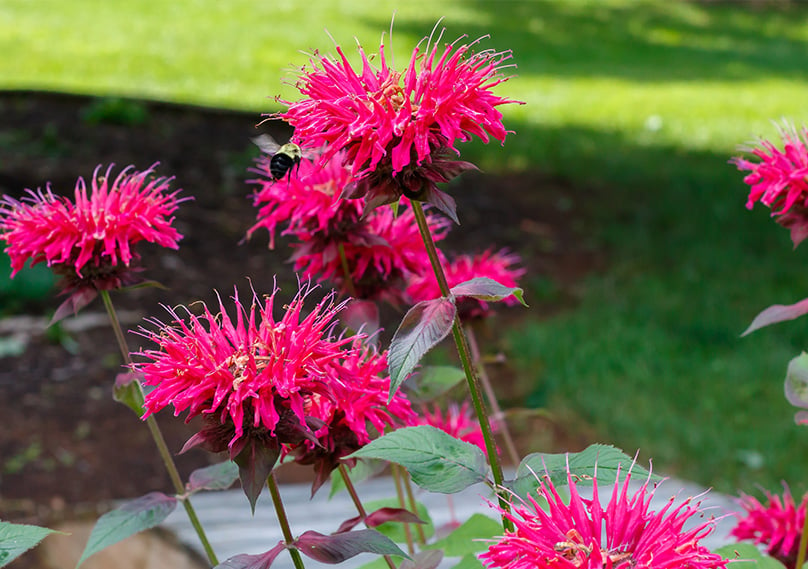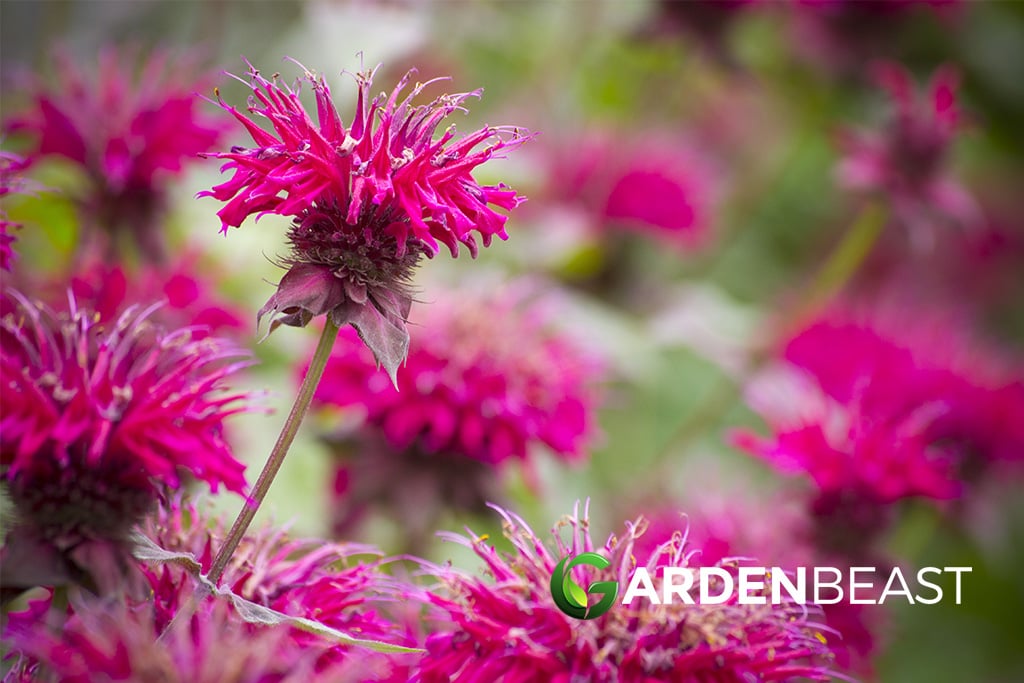Bee balm, also known by its botanical name, “Monarda,” is a tall, perennial that’s native to Northern America. Also known as the “bergamot,” the bee balm flowers produce a citrus scent that’s similar to what you might expect when cutting up a bergamot orange.
The native American population refers to bee balm as “Oswego tea,” making a brew from the leaves of the plant, which have a slightly minty taste and fragrance. Bee balm is a popular addition to jams and jellies, and the leaves bring extra flavor to salads.
The flowers of the bee balm plant have a shaggy and colorful appearance, and gardeners can plant bee balm in the herb garden, as well as the perennial border around the yard.
Bee Balm Characteristics
Family and scientific name – Bee balm is a member of the mint family (Lamiaceae), with the botanical name Monarda didyma.
- Plant type – The bee balm is a perennial herb.
- Flowering season – Summertime, and gardeners must cut back the perennial before the winter arrives.
- USDA growing zones – Bee balm goers readily in USDA zones 4 through 10.
- Hardiness – The bee balm is tolerant of both cold and warm climates, and resists cold temperatures down to -20F.
- Plant size and form – The bee balm grows to between three to five feet tall. This bushy plant produces leafy branches growing from clumps, with a shallow root system that allows the plant to spread its roots.
- Flowers – The bee balm bursts into bloom, featuring dual-lipped flowers forming a spectacular display of tiered whorls at the tip of the stems. The color of the flowers ranges from scarlet, to purple, pink, and white. The flowers produce a rich citrus aroma that smells marvelous in the garden throughout the peak of summer.
- Blooming time – Bee balm blooms from the early to late summer in the United States. If the gardener deadheads the dying flowers, then they can expect a second blooming shortly afterward.
- Foliage – The bee balm produces dark-green leaves, with a toothed appearance. The leaves grow opposite to one another, and on square stalks, a characteristic of plants in the mint family. The surface of the leaf feels somewhat fuzzy to touch.
- 500+ Bee Balm Flower Seeds Perennial Monarda Didyma Bee Balm Seeds Heirloom Seeds for Planting Non-GMO Seeds - Open-Pollinated
- If you have any questions about our products, please feel free to contact us.
- Seeds per pack: 100
- Ultra-colorful, wonderfully fragrant, frizzy 1 1/4- to 1 3/4-inch blooms in 4 hot colors light up the midsummer garden! This foolproof Monarda mix boasts scented flowers and foliage, for a dramatic impact in the garden or vase.
- The blooms of bright red, scarlet, pink, and salmon are as long-lasting as they are dramatic, heralding the arrival of midsummer to the garden.
- Nothing brings in the butterflies, hummingbirds, and bees like Monarda, and these vigorous, bushy 2- to 4-foot plants bloom profusely, with up to 20 long stems per plant. Excellent for cutting!
- Best in consistently moist soil receiving full sun or afternoon shade, this Bee Balm is a trouble-free joy for garden and vase. An excellent cut flower, they are also a great choice for Northern gardens.
- QUALITY - All seeds packaged by Seed Needs are intended for the current and the following growing seasons. All seeds are stored in a temperature controlled facility that is free of significant amounts of moisture.
- QUANTITY - Seed packets by Seed Needs offer generous quantities. You can share with friends and family, or save your extra seeds until the next season, if properly stored.
- PACKETS - Each packet displays a beautiful illustration of the variety to be grown, as well as detailed seed sowing information on the reverse side as well. Measures 3.25” wide by 4.25” tall.
- PROMISE - Seed Needs will never knowingly supply GMO based seed products. The vast majority of our seeds are open pollinated & heirloom, with the exception of a few hybrids.
- GERMINATION - Seed Needs packets contain some of the freshest seed available. Direct from the growers. If sown correctly, you will begin seeing results in only a matter of days.
Last update on 2024-10-03 / Affiliate links / Images from Amazon Product Advertising API
Planting Tips for Bee Balm
The plant will do well in the full sunlight, but it prefers areas of the garden that get afternoon shade. Plant your bee balm in an area that gets adequate airflow to the plant. The bee balm might start to show signs of white powdery mildew forming on the leaves and flowers if the plant doesn’t get enough air, especially after heavy rains.
Preparing the Soil
Plant your bee balm in soil that has sufficient drainage to prevent root rot. Bee balms prefer nutrient-dense soils that have plenty of organic matter. Bee balm grows well in soil that has a pH of between 6.5 to 8, preferring an alkaline soil over an acidic mix.
Dig a hole for the root ball of the plant, and then fork in some organic compost. Place the plant in the hole and backfill with excavated soil and compost until the roots are just below the soil’s surface. Lightly pack the soil around the roots and then water heavily.
Starting Seeds Indoors
Gardeners that what to grow bee balm from seed should begin the germination process indoors in the early spring. For best results, start sprouting your seeds in the 8-weeks before the last frost hits the ground.
Gardeners can start their seeds in pots or flats seedling trays, and provide the seedlings with light from a fluorescent bulb positioned 5-inches above the soil surface. The temperature in the room should not fall below 55F.
Transplanting Your Seedlings to the Garden
After your bee balm germinates, give it a few weeks to establish a root system before planting it into the garden. Well-rooted plants can survive the last frost of the season when planting them into the garden. If you’re planting cuttings or seedlings, then wait until the late spring to plant.
Planting Outdoors
Gardeners can start their bee balm planting in the garden in the mid-spring after the last frosts fall. Check your local listings for frost dates in your area. Plant the bee balm to a depth of ¼ to ½-inch deep, and space plants 12-inches apart.
Bee balm grows in clumps and spreads through the planting site quickly. A single cluster may require 2-square feet of space or more.
Bee Balm Growing Tips
Watering
Bee balm likes a moderate watering schedule. Gardeners should ensure that the soil dries out completely between waterings, allowing the plant to avoid getting “wet feet,” that may cause the onset of root rot.
Bee balm is less likely to be as invasive during drier watering conditions. However, if you leave in a region of the U.S. that experiences heavy rainfalls, you can expect your bee balm to reach a monstrous size.
Fertilizing Your Bee Balm
Gardeners can apply a ½-inch layer of mulch or compost to the base of the plant for additional nutrients during the growing season. Add the mulch in the later spring to kick start growth. Bee balms also enjoy feeding with a 10-10-10 fertilizer during the later springtime.
Caring for Your Bee Balm
Gardeners must ensure that they dig or pull out all the new shoots coming from the plant. It’s also important to note that shallow roots can form mats that become invasive in moist soils.
Some gardeners who grow bee balm in moist soil will prefer to encircle the roots with a steel cage when planting in the garden, preventing the roots from spreading and choking other plants.
Ensure that you cut back the bee balm to keep it growing throughout the season, and to keep it in check. Divide your bee balms every 4-years to keep a lid on the spread of the plant.

- Bee Balm Flowers
Pests and Diseases Affecting Bee Balm
Gardeners will find it surprising that bee balm is a pest-free perennial. However, the plant does experience some issues with rust and white powdery mildew (WPM), especially in damp and cold conditions.
Gardeners should perform and inspection of the bee balm after each heavy rain to ensure that WPM doesn’t take hold of the plant. The late summertime is a common period of the growing season where WPM appears.
Gardeners can control WPM and rust by ensuring that they trim back any unnecessary foliage to provide the plant with airflow around the stem, leaves, and flowers. Cut back the plant to the ground in the wintertime after it finishes flowering, and prepare it for the winter.
Harvesting Bee Balm
If you’re looking to harvest the leaves from your bee balm, do it before the buds start to open. Harvest the leaves as required, and send them to drying screens or trays. The leaves should dry out in 2 to 3-days, provided they are in a warm and shady place in the garden or garage.
Those gardeners who store their harvest in burlap sacks or mesh bags find that the leaves dry in 2 to 7-days, depending on the climate.
Propagating Bee Balm Plants
Gardeners can grow their bee balms from seeds, cuttings, or divisions.
Growing Bee Balm from Seed
Place your seeds in the refrigerator for three months before germination. This situation simulates the wintertime, allowing the seeds to sprout when they detect the change in temperature as you remove them from the fridge.
Germination should start in 14 to 21-days after removing the seeds from the fridge. Sow your bee balm seeds indoors and then transplant them outdoors as the root system starts to form.
Dividing Bee Balm
Gardeners can divide their bee balm plants between the fall or early spring. It’s an essential practice to divide your plants, or they might start to invade other plants and flowerbeds around the garden.
Divide the bee balm every three years, and replant the divisions in flowerbeds with compost amendments in the soil. It’s important to note that the center of the bee balm tends to die-off, so take your divisions from the outside edges of the clumps.
Bee Balm Companion Plants
Bee balm comes in so many different colors that it works with any of the other plants in a summer garden.
The bee balm makes an excellent companion for the garden phlox or Shasta daisy. The bee balm is a mid-border perennial, meaning that it suits growing alongside lower-growing perennial plants, such as dwarf Amsonia, helping to cover the sparse lower region of the bee balm.
We enjoy planting our bee balm with daylilies or variegated phlox, or echinacea. Gardeners should match their bee balm with plants that enjoy similar growing conditions. Ensure that you don’t overcrowd the bee balm, as it affects their growth rate and flowering time.
Popular Bee Balm Varieties
Bee balm varieties popular in gardens across North America include the following.
- ‘Cambridge Scarlet’ – Red flowers on spiky leaves
- ‘Croftway Pink’ –Pink flowers
- ‘Lemon mint’ – Purple-pink flowers
- ‘Marshall’s Delight’ – Pink blooms
- ‘Raspberry Wine’ – Scarlet flowers with undertones of lilac
- ‘Wild bergamot’ – Lavender flowers that produce a potent fragrance



